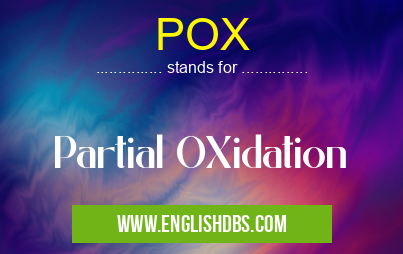What does POX mean in CHEMISTRY
POX stands for Partial OXidation. It is a process that involves the incomplete oxidation of organic compounds. This process is typically carried out using a catalyst, such as a metal oxide, and a reducing agent, such as hydrogen or carbon monoxide.

POX meaning in Chemistry in Academic & Science
POX mostly used in an acronym Chemistry in Category Academic & Science that means Partial OXidation
Shorthand: POX,
Full Form: Partial OXidation
For more information of "Partial OXidation", see the section below.
POX Process
The POX process is typically used to convert hydrocarbons into oxygenated compounds, such as alcohols, aldehydes, and ketones. The process can be carried out in either a gas-phase or liquid-phase reactor. In a gas-phase reactor, the reactants are passed over a catalyst bed, while in a liquid-phase reactor, the reactants are dissolved in a solvent.
The POX process is a versatile process that can be used to produce a variety of oxygenated compounds. The process is relatively simple to operate and can be used to produce high-quality products.
Applications of POX
The POX process is used in a variety of applications, including:
- The production of acetic acid
- The production of formaldehyde
- The production of acetaldehyde
- The production of maleic anhydride
Essential Questions and Answers on Partial OXidation in "SCIENCE»CHEMISTRY"
What is Partial Oxidation (POX)?
Partial Oxidation (POX) is a chemical process that involves the incomplete oxidation of a hydrocarbon feedstock, typically natural gas, to produce a synthesis gas (syngas) mixture. This syngas primarily consists of hydrogen and carbon monoxide and is used as a feedstock for various downstream processes, such as the production of methanol, ammonia, and synthetic fuels.
What are the advantages of POX over other syngas production methods?
POX offers several advantages over other syngas production methods, including:
- High efficiency: POX processes are highly efficient at converting the hydrocarbon feedstock into syngas, maximizing the utilization of the raw materials.
- Flexibility: POX can be tailored to process a wide range of hydrocarbon feedstocks, making it suitable for various applications.
- Lower emissions: POX processes typically produce lower emissions of greenhouse gases and other pollutants compared to other methods.
What are the key factors influencing the POX process?
The POX process is influenced by several key factors, including:
- Temperature: The temperature of the reaction affects the selectivity of the process and the yield of syngas.
- Pressure: The pressure of the reaction affects the conversion rate and the equilibrium of the chemical reactions.
- Catalyst: The type of catalyst used in the POX process significantly impacts the efficiency and selectivity of the reaction.
What are the challenges associated with POX?
POX processes face certain challenges, including:
- Catalyst deactivation: The catalysts used in POX can be susceptible to deactivation over time, leading to reduced efficiency and increased maintenance requirements.
- Carbon formation: Incomplete combustion during the POX process can result in the formation of carbon deposits, which can affect the performance of the catalyst and equipment.
- Process integration: Integrating POX with other downstream processes, such as syngas utilization, requires careful engineering and optimization.
What is the future outlook for POX technology?
POX technology is expected to play a crucial role in the transition to a more sustainable energy future. As the demand for clean and efficient energy sources grows, POX processes offer a promising solution for producing syngas from various feedstocks, including renewable sources. Continued research and development efforts are focused on improving the efficiency, reducing emissions, and expanding the applications of POX technology.
Final Words: The POX process is an important industrial process that is used to produce a variety of oxygenated compounds. The process is relatively simple to operate and can be used to produce high-quality products.
